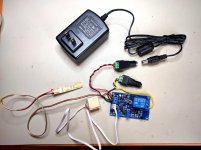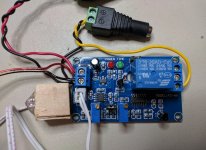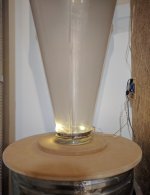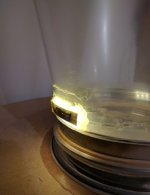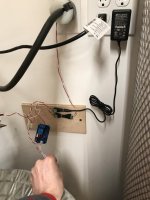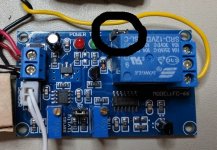A buddy was over using the shop this week -- we planed several hundred linear feet of spruce 2x10 for a project of his. And in the course of doing so, managed to overflow the bin/cyclone/filters twice (!).
A tip on recovering from this: First, empty and replace the dust bin. Then loosely connect a flex hose intake to the filter clean-out box, and let'er rip! Give the filters a few taps/shakes while it's circulating, and they'll come out fairly clean in short order.
After we finished for the day, attention turned to preventing future overflows. With the demise of the McRabbet bin sensor offering, I have decided to roll my own. This thread will document the materials and progress.
Previous efforts (eg. McRabbet) used standard garage door optical sensors. While readily available, they do cost a few pennies, and require some circuitry to interpret the pulsed output. I can easily cobble that kind of thing together, but there may be simpler solutions available these days.
On Amazon, I found a 12V "Photoresistor Relay" board with sensor for about CAD$10, which should do the trick. It'll be here by this weekend. The plan is to mount that device on the outside/top of the bin lid, and tape/glue (hot-melt!) the sensor to either the clear flex hose there, or directly to the bottom of the cyclone itself. Most likely the latter in my case, as the setup here has only about 1" of flex hose between cyclone and bin lid (an extra tall bin). I'll put a 12V LED bulb on the side opposite the sensor, and wrap black tape around the circumference, shielding the setup from strong stray ambient light.
Both the bulb and the "Photoresistor Relay" board will be powered by a 12V/2A AC adapter, plugged into the 120V output from the CV remote control receiver. So it gets powered only when the cyclone itself is "ON". That same 12V AC adapter will also be used to pass power through the board's relay contacts to a 12V LED "flashing light" of the type intended to magnetically attach to the roof of a vehicle. These are readily available from Walmart, Canadian Tire, Amazon, etc.. for CAD$35-$50 or so.
When the light from the 12V bulb is interrupted by a pile of sawdust (due to the bin being full), the relay will trigger and the "flashing light" will illuminate and do its thing. I'll be mounting that device upside down on the ceiling of the workshop so that is easily noticed from anywhere in the shop. The same relay can also simultaneously be used to cut power to the cyclone relay if desired, shutting off the CV blower.
That's the plan -- the principal unknown at this point is whether or not some extra hysteresis is required. In other words, is some extra averaging or a delay needed to allow for momentary blockage of the beam? TBD. Stay tuned for updates, and feel free to contact me for direct links to The Exact Stuff I am using here.
Cheers
Mark
A tip on recovering from this: First, empty and replace the dust bin. Then loosely connect a flex hose intake to the filter clean-out box, and let'er rip! Give the filters a few taps/shakes while it's circulating, and they'll come out fairly clean in short order.
After we finished for the day, attention turned to preventing future overflows. With the demise of the McRabbet bin sensor offering, I have decided to roll my own. This thread will document the materials and progress.
Previous efforts (eg. McRabbet) used standard garage door optical sensors. While readily available, they do cost a few pennies, and require some circuitry to interpret the pulsed output. I can easily cobble that kind of thing together, but there may be simpler solutions available these days.
On Amazon, I found a 12V "Photoresistor Relay" board with sensor for about CAD$10, which should do the trick. It'll be here by this weekend. The plan is to mount that device on the outside/top of the bin lid, and tape/glue (hot-melt!) the sensor to either the clear flex hose there, or directly to the bottom of the cyclone itself. Most likely the latter in my case, as the setup here has only about 1" of flex hose between cyclone and bin lid (an extra tall bin). I'll put a 12V LED bulb on the side opposite the sensor, and wrap black tape around the circumference, shielding the setup from strong stray ambient light.
Both the bulb and the "Photoresistor Relay" board will be powered by a 12V/2A AC adapter, plugged into the 120V output from the CV remote control receiver. So it gets powered only when the cyclone itself is "ON". That same 12V AC adapter will also be used to pass power through the board's relay contacts to a 12V LED "flashing light" of the type intended to magnetically attach to the roof of a vehicle. These are readily available from Walmart, Canadian Tire, Amazon, etc.. for CAD$35-$50 or so.
When the light from the 12V bulb is interrupted by a pile of sawdust (due to the bin being full), the relay will trigger and the "flashing light" will illuminate and do its thing. I'll be mounting that device upside down on the ceiling of the workshop so that is easily noticed from anywhere in the shop. The same relay can also simultaneously be used to cut power to the cyclone relay if desired, shutting off the CV blower.
That's the plan -- the principal unknown at this point is whether or not some extra hysteresis is required. In other words, is some extra averaging or a delay needed to allow for momentary blockage of the beam? TBD. Stay tuned for updates, and feel free to contact me for direct links to The Exact Stuff I am using here.
Cheers
Mark
Last edited:

